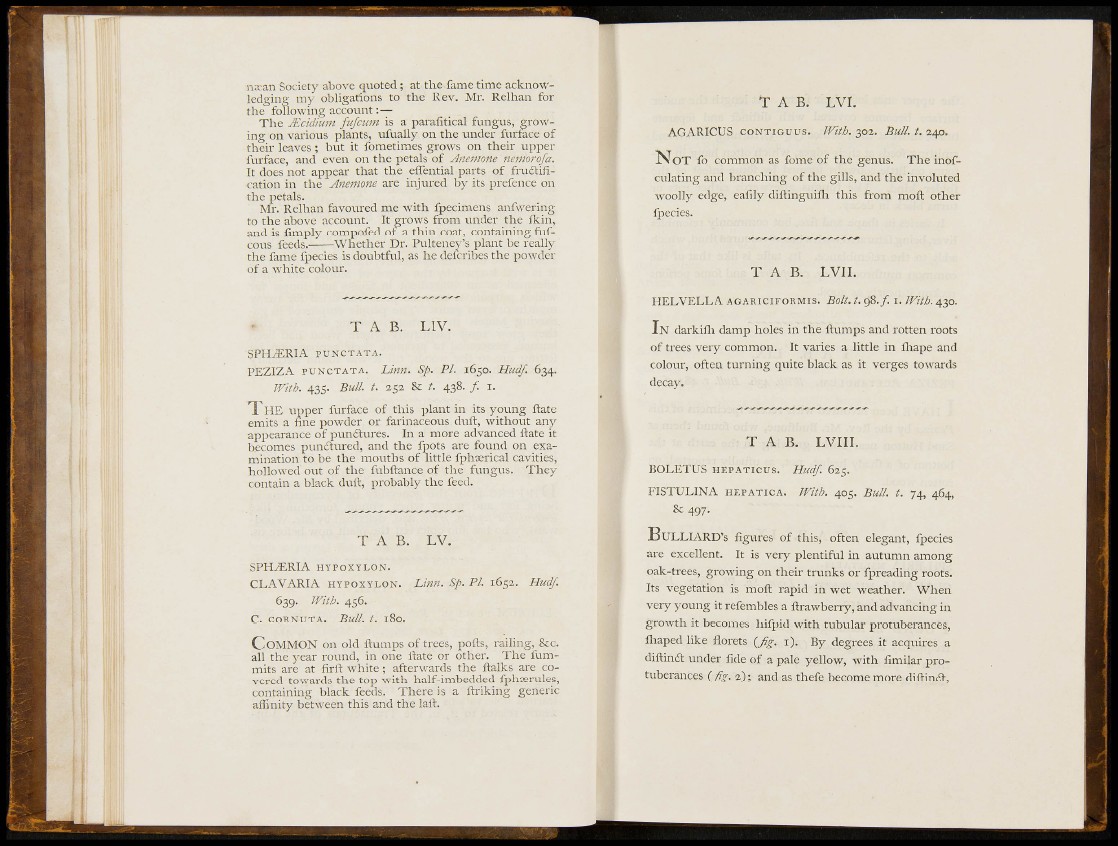
»
m an Society above quoted; at the fame time acknowledging
my obligations to the Rev. Mr. Relhan for
the following account:—
The JEcidmm fufcum is a parafitical fungus, growing
on various plants, vifually on the vmder furface of
their leaves ; but it foraetim.es grows on their upper
furface, and even on the petals of Anemone nemorofa.
It does not appear that the eifential parts of fruftification
in the Anemone are injured by its prefence on
the petals.
Mr. Relhan favoured me with fpecimens anfwering
to the above account. It grows from under the ikin,
and is limply compofed of a thin coat, containing fufcous
feeds.. Whether Dr. Pulteney's plant be really
the fame fpecies is doubtful, as he defcribes the powder
of a white colour.
T A B. LIV.
SPHIERIA PUNCTATA.
PEZIZA PUNCTATA. Linn. Sp. PL 1650. Hudf. 634.
With. 435- Bull. A 252 & t. 438. f. I.
T H E upper furface of this plant in its yoting ftate
emits a fine powder or farinaceous duft, without any
appearance of punilures. In a more advanced ftate it
becomes punitured, and the fpots are found on examination
to be the mouths of little fpha:rical cavities,
hollowed out of the fabftance of the fungus. They
contain a black duft, probably the feed.
T A B . LV.
S P H ^ R I A HYPOXYLON.
CLAVARIA HYPOXYLON.
639. With. 456.
C. CORNUTA. Bull. t. 180.
Unn. Sp. PI. 1652. Hudf.
COMMON on old ftumps of trees, pofts, railing, &c.
all the year round, in one ftate or other. The fummits
are at firft white; afterwards the ftalks are covered
towards the top with half-imbedded fphzerules,
containing black feeds. There is a ftriking generic
affinity between this and the laft.
T A B . LVI.
AGARICUS coNTiGuus. IVith. 302. Bull. t. 240.
N o t fo common as fome of the genus. The inofculating
and branching of the gills, and the involuted
woolly edge, eafdy diftinguifli this from moil other
fpecies.
T A B. LVII.
HELVELLA AGARICIFORMIS. Bolt. t. 98./. i. JVitb. 430.
I N darkiili damp holes in the ftumps and rotten roots
of trees very common. It varies a little in flrape and
colour, often turning quite black as it verges towards
decay.
T A B . LVIII.
BOLETUS HEPATicus. Hudf. 625.
FISTULINA HEPATicA. mtb. 405. Bull. t. 74, 464,
& 497.
BULLIARD'S figures of this, often elegant, fpecies
are excellent. It is very plentiful in autumn among
oak-trees, growing on their trunks or fpreading roots.
Its vegetation is moft rapid in wet weather. When
very young it refembles a ftrawberry, and advancing in
growth it becomes hifpid with tubular protuberances,
lliaped like florets (Jg. i). By degrees it acquires a
diftina under fide of a pale yellow, with fimilar protuberances
{Jig. 2); and as thefe become more diftinft,